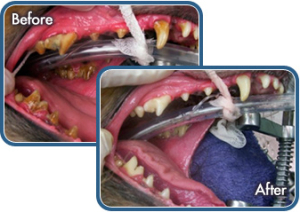AAHA Dental Care Guidelines
Why Dental Care Is Important
Periodontal Disease
How It Starts and Progresses
AAHA Guidelines
-
Pre-anesthetic exam–Your veterinarian should examine your pet to ensure it is healthy enough to go under general anesthesia. This examination may include:
-
Blood tests
-
Urine tests
-
Electrocardiography
-
X-rays
-
-
Anesthesia monitoring–When your pet is under anesthesia, its vital signs (such as body temperature, heart rate, and respiration) should be monitored and recorded. This helps ensure your pet’s safety while under anesthesia.
-
Dental radiographs–X-rays of your pet’s teeth are needed periodically to evaluate your pet’s oral health. X-rays also help veterinarians detect abnormalities that cannot be seen through physical examination alone. They can also confirm the need for tooth extraction when teeth are loose or badly infected.
-
Scaling and polishing–Using instruments much like human dentists, veterinarians remove plaque and calculus from your pet’s teeth. Polishing with a special paste smoothes out scratches to the tooth enamel.
-
Fluoride/sealants–By applying an anti-plaque substance, such as a fluoride treatment and/or a barrier sealant, the veterinarian helps strengthen and desensitize teeth and discourage the development of future plaque.
Home Dental Care
Facts about Anesthesia Free Dentistry:
Taken from a statement from American Veterinary Dental College, supported by AAHA and the AVMA:
In the United States and Canada, only licensed veterinarians can practice veterinary medicine. Anyone providing dental services other than a licensed veterinarian, or a supervised and trained veterinary technician, is practicing veterinary medicine without a license and shall be subject to criminal charges.
Owners of pets naturally are concerned when anesthesia is required for their pet. However, performing this procedure on an un-anesthetized pet is inappropriate for the following reasons:
1. Dental tartar is firmly adhered to the surface of the teeth. Scaling to remove tartar is accomplished using ultrasonic and sonic power scalers, plus hand instruments that must have a sharp working edge to be used effectively. Even slight head movement by the patient could result in injury to the oral tissues of the patient, and the operator may be bitten when the patient reacts.
2. Professional dental scaling includes scaling the surfaces of the teeth both above and below the gingival margin (gum line), followed by dental polishing. The most critical part of a dental scaling procedure is scaling the tooth surfaces that are within the gingival pocket (the subgingival space between the gum and the root), where periodontal disease is active. Access to the subgingival area of every tooth is impossible in an un-anesthetized canine or feline patient. Removal of dental tartar on the visible surfaces of the teeth has little effect on a pet’s health, and provides a false sense of accomplishment. The effect is purely cosmetic.
3. Inhalation anesthesia using a cuffed endotracheal tube provides three important advantages… the cooperation of the patient with a procedure it does not understand, elimination of pain resulting from examination and treatment of affected dental tissues during the procedure, and protection of the airway and lungs from accidental aspiration.
4. A complete oral examination, which is an important part of a professional dental scaling procedure, is not possible in an un-anesthetized patient. The surfaces of the teeth facing the tongue cannot be examined, and areas of disease and discomfort are likely to be missed. Radiographs can not be performed to assess the health of tooth roots and bone where dog and cats have most of their dental disease, therefore underlying problems are left to become worse.
There are multiple states with charges against people causing harm while performing this procedure and it was recently banned in New Jersey, with more states beginning to follow this trend.
Safe use of an anesthetic or sedative in a dog or cat requires evaluation of the general health and size of the patient to determine the appropriate drug and dose, and continual monitoring of the patient. Veterinarians are trained in all of these procedures. Prescribing or administering anesthetic or sedative drugs by a non-veterinarian can be very dangerous, and is illegal. Although anesthesia will never be 100% risk-free, modern anesthetic and patient evaluation techniques used in veterinary hospitals minimize the risks, and millions of dental scaling procedures are safely performed each year in veterinary hospitals.
November 2013 new AAHA guidelines: “All dental procedures are performed under general anesthesia with patients intubated.” AAHA sets standard-of-care guidelines for American Animal Hospitals
![]()

